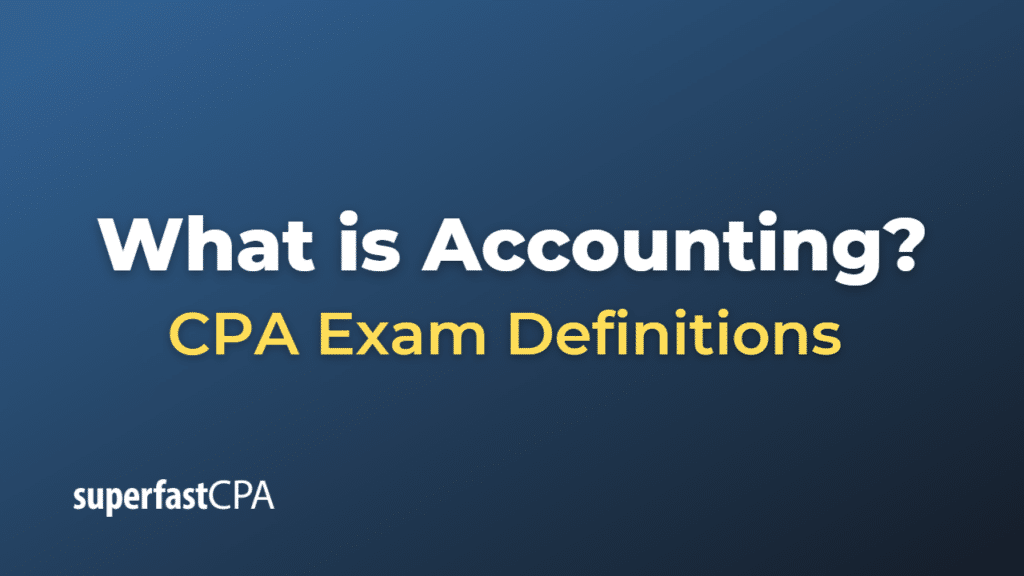Accounting
Accounting is the systematic process of recording, summarizing, analyzing, and interpreting financial transactions and events. It is often referred to as the “language of business” because it provides essential information for decision-makers, investors, regulators, and other stakeholders to understand the financial health and performance of a business or organization.
The primary objectives of accounting are to:
- Record financial transactions: Accounting involves tracking and documenting all financial transactions, such as sales, purchases, and expenses, in a consistent and organized manner. This process is critical for maintaining accurate financial records and ensuring that transactions are accounted for properly.
- Summarize financial data: Accounting involves preparing financial statements that summarize an organization’s financial position and performance over a specific period. The main financial statements include the income statement, balance sheet, and cash flow statement. These statements provide a snapshot of the organization’s financial health and help stakeholders assess its performance.
- Analyze and interpret financial information: Accountants analyze financial data to identify trends, anomalies, and opportunities for improvement. This analysis helps management make informed decisions about the organization’s operations, investments, and financing activities.
- Ensure compliance with laws and regulations: Accounting plays a crucial role in ensuring that organizations comply with applicable laws and regulations, such as tax laws and financial reporting standards. Accountants must stay up-to-date with changes in these regulations and ensure that their organization’s financial practices adhere to the required standards.
- Facilitate communication and decision-making: Accounting provides essential information for stakeholders, such as management, investors, creditors, and regulators, to make informed decisions about the organization’s operations and performance. By presenting financial information in a clear and consistent format, accounting facilitates communication and understanding among these stakeholders.
- Assess and manage risk: Accounting helps organizations identify, assess, and manage various risks, such as credit risk, liquidity risk, and operational risk. By monitoring financial data and implementing internal controls, accountants can help organizations mitigate potential risks and enhance their overall financial stability.
Accounting can be divided into several branches, including financial accounting, management accounting, cost accounting, tax accounting, and auditing. Each of these branches serves different purposes and addresses the specific needs of various stakeholders. In general, accounting plays a vital role in ensuring the efficient functioning of businesses and financial markets by providing accurate, reliable, and transparent financial information.
Example of Accounting
Let’s consider a fictional example of a small bakery called “Delightful Bakes” to illustrate how accounting is used in a real-life business scenario.
- Record financial transactions: The owner of Delightful Bakes, Sarah, keeps track of all financial transactions, such as sales revenue, inventory purchases, payroll expenses, and rent payments. She records these transactions in the bakery’s general ledger using a double-entry bookkeeping system, which helps maintain accurate financial records.
- Summarize financial data: At the end of each month, Sarah prepares financial statements for Delightful Bakes. She creates an income statement that shows the bakery’s revenues, expenses, and net income for the month. She also prepares a balance sheet that summarizes the bakery’s assets, liabilities, and equity at the end of the month.
- Analyze and interpret financial information: Sarah reviews the financial statements to assess the bakery’s performance and identify areas for improvement. She notices that the cost of goods sold has increased significantly over the past few months, which has reduced the bakery’s net income. Based on this analysis, she decides to negotiate better pricing with her suppliers and implement cost-saving measures in the production process.
- Ensure compliance with laws and regulations: Sarah ensures that Delightful Bakes complies with all applicable tax laws and financial reporting standards. She files the bakery’s tax returns accurately and on time, and she follows Generally Accepted Accounting Principles (GAAP) when preparing the financial statements.
- Facilitate communication and decision-making: Sarah shares the financial statements with her business partner, who is also an investor in the bakery. The financial information helps them make informed decisions about the bakery’s operations, such as whether to expand the menu, invest in new equipment, or open a second location.
- Assess and manage risk: Sarah regularly reviews the bakery’s financial data and internal controls to identify potential risks, such as cash flow problems or inventory management issues. She implements appropriate measures to mitigate these risks and safeguard the bakery’s financial stability.
In this example, accounting plays a critical role in helping Sarah manage Delightful Bakes effectively and make informed decisions about the bakery’s operations, finances, and growth. By maintaining accurate financial records, preparing financial statements, analyzing and interpreting financial information, ensuring compliance with laws and regulations, and assessing and managing risk, Sarah can better understand her business’s financial health and work towards achieving its goals.













